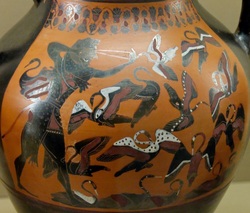STYMPHALIAN BIRDS
(Stymphalides)

Heracles and Stymphalian Birds, c. 540 BCE
S. A. Scrull
Greek Mythology Systematized (1880)
In Arcadia was the Stymphalian Lake, which was inhabited by birds of most terrible appearance. With their claws and bills of brass they could pierce the strongest armor, and it was said that they were armed with darts. Even Heracles would have been unable to cope with these enemies had not Athena given to him a brazen rattle that frightened the birds and caused them to rise into the air, where they were pierced with arrows.
Source: S. A. Scull, Greek Mythology Systematized (Philadelphia: Porter & Coates, 1880).
Photo credit: Wikimedia Commons
Apollodorus | THE LIBRARY | 2.5.6
The sixth labour he [Eurystheus] enjoined on him [Heracles] was to chase away the Stymphalian birds. Now at the city of Stymphalus in Arcadia was the lake called Stymphalian, embosomed in a deep wood. To it countless birds had flocked for refuge, fearing to be preyed upon by the wolves. So when Hercules was at a loss how to drive the birds from the wood, Athena gave him brazen castanets, which she had received from Hephaestus. By clashing these on a certain mountain that overhung the lake, he scared the birds. They could not abide the sound, but fluttered up in a fright, and in that way Hercules shot them.
(Trans,. J. G. Frazer, 1921)
From THE CELESTIAL EQUATOR OF ARATOS
Robert Brown, Jr.
1892
ROBERT BROWN, JR. (1844-1912) was a British solicitor and amateur Orientalist, as well as a fraudulent psychic medium. He spent years investigating the origin of the constellations, concluding correctly but for the wrong reasons that the Greek constellations originated in those of Babylon. In this excerpt from a paper presented at the 1892 International Congress of Orientalists, Brown discusses the Stymphalian Birds and proposed an astronomical explanation based on Near Eastern constellation lore.
The constellational birds Eagle and Raven are stellar reduplications of the tempest, the Akkadian "divine Storm-bird," Lugal-tudda ("the Lusty-king "), called by the Semitic Babylonians Zu, a word meaning both "stormy wind" and a kind of vulture. These storm-birds are particularly noticed as flesh-eating, and are warred against by Merôdaχ- Thus, on a cylinder he is shown successfully attacking three large and evidently ferocious birds; he seizes one by the neck, another by the leg, and tramples on the third. When the Semitic Sun-god became identified, on account of the local proximity of their votaries, with the Aryan solar hero Herakles, the exploits of the former were transferred to the latter. I have already referred to Panyasis of Halikarnassos as a labourer in this field, and another was Peisandros the Rhodian, of Kameiros, cir. B.C. 648, who, in his Herakleia, gave an account of a contest between Herakles and the great flesh-eating birds, which were afterwards connected with the region of Stymphalos in Arkadia. Later Greek art represented Herakles, armed with bow and arrow, shooting at three Stymphalian birds, the same number as are shown on the cylinder; but Pausanias specially notices that Peisandros does not say that Herakles slew the birds, but that he drove them away by the sound of " rattles" (κροτάλων),a word applied to the "castanets" used in the Kybele cult. This is evidently an earlier phase of the story; Pausanias, who connects the Stymphalian birds with Arabia, i.e., with the East, notices also the usual story of their destruction by the arrows of the hero. No bow or arrows are shown on the cylinder, nor does it appear from the design that the birds are being actually killed. "Pisander," says K. O. Müller, "was, as far as we know, the first who represented in detail the combats of Herakles with wild beasts;" legends which he obtained from the Semitic East. Thus, on a Kypriot-cylinder, "manifestly a rude imitation of a Babylonian gem," is represented "the battle between Merodach and the demon-birds." The Stymphalian birds are said by Mnaseas, the learned Alexandrian grammarian, to have been daughters of Ornis, i.e., the constellational Bird of Aratos, known as Kyknos, the Swan; and Kyknos is also represented as a son of Ares, and is said to have been killed in single combat by Herakles, just as Hyginus tells us that Herakles slew the Stymphalian birds "in insula Martis." The Aryan Ares-Mars is the analogue of the Euphratean Storm-god, and so the Storm-bird-clouds, children of the latter, become connected with the former.
Source: Robert Brown, Jr., "The Celestial Equator of Aratos," Transactions of the Ninth International Congress of Orientalists, ed. E. Delmar Morgan, vol. 2 (London: Committee of the Congress, 1893), 478-479.



